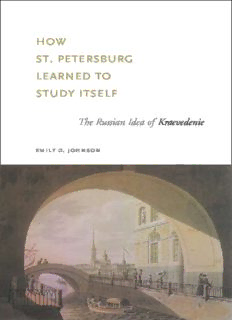
How St. Petersburg Learned to Study Itself: The Russian Idea of Kraevedenie (Studies of the Harriman Institute) PDF
Preview How St. Petersburg Learned to Study Itself: The Russian Idea of Kraevedenie (Studies of the Harriman Institute)
how st. petersburg learned to study itself The Russian Idea of Kraevedenie emily d. johnson how st. petersburg learned to study itself i-xvi_Johnson_FM.indd 1 4/24/06 11:21:13 AM studies of the harriman institute: selected titles in russian literature and history the pennsylvania state university press university park, pennsylvania i-xvi_Johnson_FM.indd 2 4/24/06 11:21:13 AM how st. petersburg learned to study itself The Russian Idea of Kraevedenie emily d. johnson i-xvi_Johnson_FM.indd 3 4/24/06 11:21:13 AM Disclaimer: Some images in the original version of this book are not available for inclusion in the eBook. Studies of the Harriman Institute, Columbia University The Harriman Institute, Columbia University, sponsors the Studies of the Harriman Institute in the belief that their publication contributes to scholarly research and public understanding. In this way, the Institute, while not necessarily endorsing their conclusions, is pleased to make available the results of some of the research conducted under its auspices. Library of Congress Cataloging-in-Publication Data Johnson, Emily D., 1966– How St. Petersburg learned to study itself : the Russian idea of kraevedenie / Emily D. Johnson. p. cm. — (Studies of the Harriman Institute) Includes bibliographical references and index. isbn 0-271-02872-6 (cloth : alk. paper) 1. Saint Petersburg (Russia)—History—Study and teaching—History. 2. Saint Petersburg (Russia)—Historiography—History. 3. Local history—Study and teaching—Russia (Federation)—Saint Petersburg. 4. Saint Petersburg (Russia)—Civilization. I. Title. II. Title: How Saint Petersburg learned to study itself. III. Series. DK561.J647 2006 947’.210072047—dc22 2005037526 Copyright © 2006 The Pennsylvania State University All rights reserved Printed in the United States of America Published by The Pennsylvania State University Press, University Park, PA 16802-1003 The Pennsylvania State University Press is a member of the Association of American University Presses. It is the policy of The Pennsylvania State University Press to use acid-free paper. This book is printed on Natures Natural, containing 50% post-consumer waste, and meets the minimum requirements of American National Standard for Information Sciences—Permanence of Paper for Printed Library Material, ansi z39.48–1992. i-xvi_Johnson_FM.indd 4 4/24/06 11:21:13 AM contents List of Illustrations vii Preface and Acknowledgments ix A Note on Transliteration and Translations xiv List of Abbreviations xv Introduction Ways of Knowing: Russian Local Studies as an Identity Discipline 1 1 The Eighteenth- and Nineteenth-Century Tradition 17 2 The Art Journals of the Silver Age, St. Petersburg Preservationism, and the Guidebook 45 3 Old Petersburg After the Revolution 73 4 The Excursion Movement and Excursion Methodology 97 5 Excursion Primers and Literary Tours 125 6 Kraevedenie in St. Petersburg 155 7 Literary Kraevedenie 183 Conclusion 215 Notes 229 Selected Bibliography 273 Index 288 i-xvi_Johnson_FM.indd 5 4/24/06 11:21:14 AM i-xvi_Johnson_FM.indd 6 4/24/06 11:21:14 AM illustrations 1. Map of St. Petersburg, from Karl Baedeker, Russia with Teheran, Port Arthur, and Peking: Handbook for Travelers (Leipzig: Karl Baedeker, 1914) viii 2. A view of St. Isaac’s bridge and the area of St. Petersburg from the Admiralty to Senate Square. Engraving from a drawing by Paterssen (1794), from M. Pyliaev, Staryi Petersburg: Rasskazy iz byloi zhizni stolitsy, 2nd ed. (St. Petersburg: Izdanie A. S. Suvorina, 1889) 42 3. A procession featuring elephants given to the Russian tsar by the Persian shah. Engraving from a watercolor by Vorobiev, from M. Pyliaev, Staryi Peterburg: Rasskazy iz byloi zhizni stolitsy, 2nd ed. (St. Petersburg: Izdanie A. S. Suvorina, 1889) 44 4. The opening of Étienne-Maurice Falconet’s monument to Peter I, The Bronze Horseman, in 1782. Engraving by Melnikov, made from a drawing by Davidov, from M. Pyliaev, Staryi Peterburg: Rasskazy iz byloi zhizni stolitsy, 2nd ed. (St. Petersburg: Izdanie A. S. Suvorina, 1889) 48 5. Evgeny Lanceray, frontispiece for World of Art, no. 1 (1902), a special issue commemorating St. Petersburg’s bicentennial 55 6. Anna Ostroumova-Lebedeva, view of the river Fontanka, from Petersburg: Avtolitografii A. P. Ostroumovoi (St. Petersburg: Komitet populiarizatsii khudozhestvennykh izdanii, 1922) 195 7. Erikh Gollerbakh, frontispiece to Erikh Gollerbakh, Gorod muz, 2nd ed. (Leningrad, 1930) 205 i-xvi_Johnson_FM.indd 7 4/24/06 11:21:14 AM fig. 1 Map of St. Petersburg from Karl Baedeker’s 1914 guide to Russia. i-xvi_Johnson_FM.indd 8 4/24/06 11:21:15 AM preface and acknowledgments In the early 1990s, I spent several years working for the Academy of Sciences in St. Petersburg, Russia, as a translator and interpreter. I arrived in country a month after the August 1991 abortive coup, witnessed the collapse of the Soviet Union firsthand, and had the disconcerting experience of living amidst hyperinflation. For a while, as I recall, food prices doubled every week. As they rose, the shelves of official grocery stores, which at one point had contained little except powdered cake mix and canned seaweed, slowly filled again. Paper money, in the volatile new economy, suddenly emerged as the chief deficit good. As prices shot up, the banks ran out of currency. Organizations, even if they theoretically had funds in their accounts, often could not meet their payroll. Salary delays of six months to a year were not uncommon, particularly in the public sector. Given the rate at which the ruble was losing its value, by the time Russian employees received the money they were owed, it was often almost worthless. In this economic climate, everyone began to look for extra sources of income. Russian scholars with international reputations, curators and restoration experts from major museums, well-known poets, the editors of important literary journals, and local political figures all agreed with alacrity to speak to groups of foreign undergraduates in exchange for very modest sums of hard currency. For a while, I spent much of my time providing consecutive interpreting for prestige lectures and guided tours: multi-week courses on pre- Revolutionary history, the development of Russian architecture, or post-Soviet political culture; back-corridor visits to architectural monuments that for one reason or another remained closed to the public; tours of the Petersburg of Brodsky and Mandelstam led by prominent literary historians. i-xvi_Johnson_FM.indd 9 4/24/06 11:21:15 AM
Description: